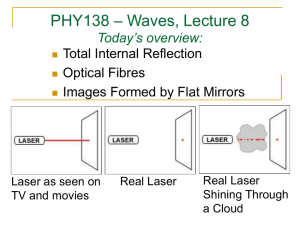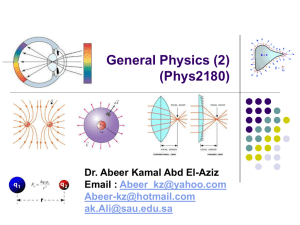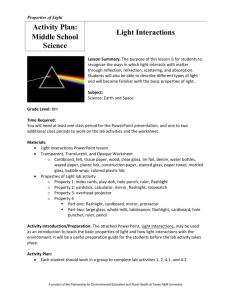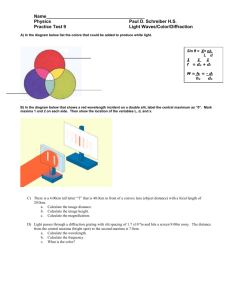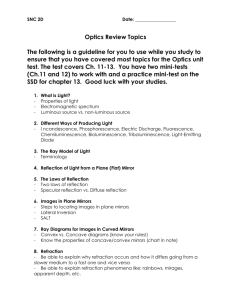lie
advertisement
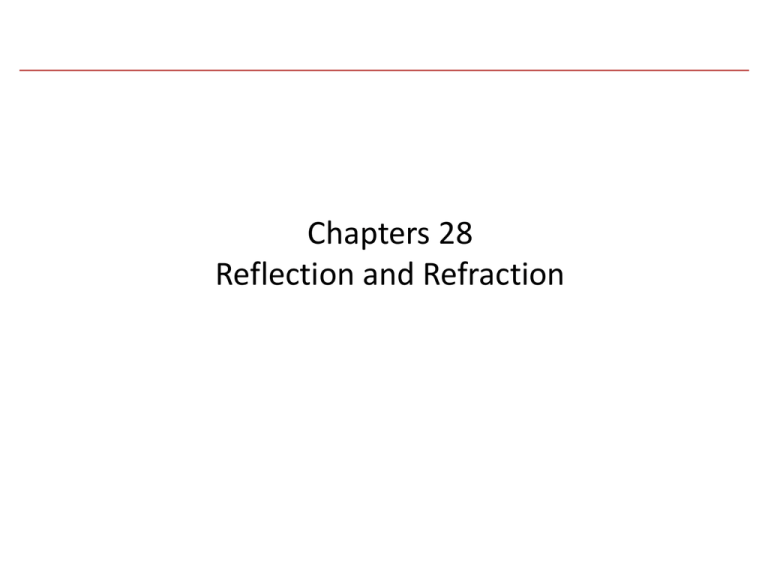
Chapters 28 Reflection and Refraction Topics • • Reflection Law of Reflection – plane mirrors – diffuse reflection • Refraction – Mirage • Cause of Refraction – dispersion – rainbows • • Total internal Reflection Lenses – images formed by lenses – lens defects Reflection - Mechanism Reflection Mirror Images Curved Mirror Images Diffuse Reflection Refraction Cause of Refraction Snell’s Law n1sinq1 = n2sinq2 where n = c/v Refraction through a Prism or Lens Examples of Refraction Where’s the Fish? Dispersion Dispersion by a Raindrop Dispersion by a Raindrop Total Internal Reflection Total Internal Reflection Lenses Lenses Magnification Magnification Lens Defects Spherical Aberration Chromatic Aberration Clicker Questions 1. Object and image for a plane mirror lie A) at right angles to each other. B) equal distances from the mirror. C) along the same plane. D) all of these E) none of these 2. When light reflects from a surface, there is a change in its A) speed. B) wavelength. C) frequency. D) all of these E) none of these 3. If you walk towards a mirror at a certain speed, the relative speed between you and your image is A) twice your speed. B) half your speed. C) your speed. D) none of these Clicker Questions 4. It is difficult to see the roadway in front of you when you are driving on a rainy night mainly because A) the film of water on the roadway makes the road less diffuse. B) light scatters from raindrops and cuts down the light to reach your eyes. C) the film of water on your windshield provides an additional reflecting surface. D) of added condensation on the inner surface of the windshield. E) none of these 5. When a mirror with a fixed beam on it is rotated through a certain angle, the reflected beam is rotated through an angle that is A) four times as large. B) twice as large. C) equal to the angle of rotation. D) none of these 6. As a light ray enters or exits a water-air interface at an angle of 15 degrees with the normal, it A) always bends toward the normal. B) always bends away from the normal. C) does not bend. D) sometimes bends towards the normal. Clicker Questions 7. A mirage is a result of atmospheric A) refraction. aberrations. B) dispersion. C) scattering. D) reflection. 8. Refraction results from differences in light's A) speed. B) frequency. C) incident angles. D) all of these E) none of these 9. Light refracts when traveling from air into glass because light A) has greater intensity in air than in glass. B) travels slower in glass than in air. C) has greater frequency in air than in glass. D) has greater frequency in glass than in air. E) has greater intensity in glass than in air. E) Clicker Questions 10. Different colors are dispersed by a prism because different colors in the prism have different A) directions. B) energies. C) speeds. D) frequencies. E) none of these 11. The image in a pinhole camera is A) always right-side up. B) sometimes inverted. C) always inverted. 12. If you wish to spear a fish with a regular spear, you should compensate for refraction between the air and water and throw your spear A) below the sighted fish. B) directly at the sighted fish. C) above the sighted fish.


